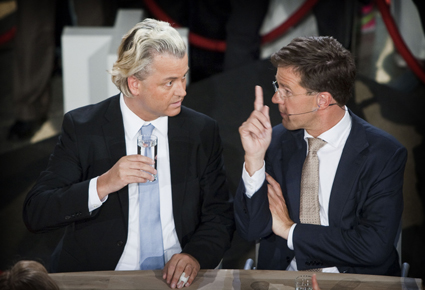It may seem hard to believe, especially as yet another bond crisis envelops Europe, but the Netherlands has less than two months to go before a new general election on September 12.![]()
As with so many elections in Europe lately, this one will be fought and won primarily on the issue of austerity.
The early election was called at the end of April following the resignation of Mark Rutte (pictured above, right) over disagreements on the Dutch budget. Rutte, whose fragile minority government was being supported by Geert Wilders’s Partij voor de Vrijheid (PVV, the Party for Freedom), had been in talks with Wilder and other government partners for weeks in an attempt to cut €16 billion from the Dutch budget, lowering the 2013 budget deficit from 4.7% of GDP to just 3% of GDP.
Wilders (pictured above, left), whose PVV vaunted to the heart of Dutch politics following the particularly fractured 2010 general election, refused to accept the cuts.
In no small part due to the populist, anti-Muslim Wilders, previous Dutch elections have focused on identity politics: protecting the particularly liberal social rights in the Netherlands (as to same-sex marriage, drug legalization and euthanasia, among others), immigration and the role of Muslims in Dutch society.
This campaign, however, is focused squarely on austerity, and while polls today show that voters are inclined to reward Rutte and his free-market, liberal Volkspartij voor Vrijheid en Democratie (VVD, the People’s Party for Freedom and Democracy), voters are also inclined to give Emile Roemer’s Socialistische Partij (SP, the Socialist Party) its best showing in Dutch political history — with projections of 30 to 32 seats. This would only further fragment the Dutch Tweede Kamer, the 150-seat lower house parliament of the Netherlands.
After the 2010 elections, it took Rutte six months of long discussions to put together a minority government. As it turned out, Rutte entered into a formal coalition with the center-right Christen-Democratisch Appèl (CDA, Christian Democratic Appeal), with outside support coming from Wilders’s populist, right-wing and anti-immigrant PVV. The latest Ipsos Netherlands poll shows that both the CDA and the PVV will lose seats in September, which could complicate Rutte’s ability to form any government and which could also prevent the adoption of the 2013 budget.
Here’s the latest composition of the lower house of the Dutch parliament:
The increasingly crowded parliament belies the fact that two parties — the CDA and the social democratic Partij van de Arbeid (PvdA, Labour Party) — dominated post-war Dutch politics until very recently, with the VVD always playing a role as a smaller third party. Under the administrations of CDA prime minister Rudd Lubbers (from 1982 to 1994) and PvdA prime minister Wim Kok (from 1994 to 2002), Dutch politics was based, by and large, on consensus. For example, Kok’s first cabinet in 1994 was a so-called “Purple Coalition” that brought together the free-market VVD with more radical parties, such as the progressive Democraten 66 (Democrats 66) and the GroenLinks (GL, GreenLeft).
Pim Fortuyn changed all of that in 2002 — the polarizing, openly gay, anti-establishment, rabidly anti-Muslim politician was assassinated just a week before the election. His party, the “Pim Fortuyn List,” won the second-highest number of seats in an election that saw seven different parties win at least 5 seats. Without Fortuyn, his movement faded in 2003 and throughout the decade, and the CDA’s Jan Peter Balkenende cobbled together four cabinets from 2002 to 2010.
Wilders picked up where Fortuyn’s movement left off, rallying voters in the 2010 election with a right-wing, anti-immigrant platform. This time around, however, Wilders is struggling. On the same day as he launched his manifesto, two PVV deputies resigned from the party, decrying Wilders’s leadership style as autocratic. But more fundamentally, Wilders has shifted radically toward an anti-Europe stance — he brought down the government over its austerity budget, he’s now opposed to the Netherlands being a member of the eurozone.
In 2010, Wilders ran circles around conventional politicians with a populist call to arms over immigration and the Muslim issue.
In 2012, Wilders is trying to use the same playbook to stir up resentment against not only austerity, but the European Union and the single currency.
The problem, for Wilders, is that Dutch voters don’t seem to be buying it — and they are galloping toward the less polarizing Roemer and his Socialists, which has been firmly on the left for decades and was the only leftist party in 2005 to oppose the European Constitution during the Dutch referendum.
With reduced support for the CDA — which had never been out of government from 1918 until 1994 — and with reduced support for the more center-left PvdA as well, even if Rutte comes out of the September election stronger, he may have no option but to try to seek a coalition that includes both the CDA and the PvdA, which also has a long history of consensus and coalition. Although the PvdA might well soften some of the budget cuts that Rutte had hoped to make, it’s certainly not going into the election on a rabble-rousing anti-euro platform.
The Netherlands has a population of just under 17 million citizens, and its GDP per capita is around $50,000 — a bit higher than Germany and France, but a bit less than Sweden, which makes it one of Europe’s relatively richer nations. While the country is not in a recession (which puts it in a better economic position than much of southern Europe), it has been in a period of relatively low growth.


2 thoughts on “Up next in the spotlight during the EU’s summer of discontent: the Netherlands”